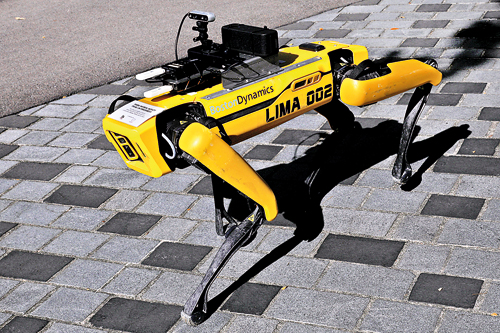Social Distancing – Can robots help us?

Spot, the Boston Dynamics robot dog, employed in a public park at Singapore to enforce social distancing
Social distancing is a term which can frequently be heard throughout the world at present as a result of COVID-19. What it means is keeping space between two persons, yourself and a person near you. This is not the natural behaviour of the human being and this is physical distancing between two persons in the society. In order to practice social or physical distancing a person should stay at least 6 feet away from another person, should not gather in groups, should stay out of crowded places and should avoid mass assemblies. In the current pandemic situation it is highly risky to carry out activities by interacting with each other without social distancing. However, in reality, maintaining human natural behaviour with social distancing is challenging and uncomfortable. Therefore, the whole world is discussing today about social distancing and how it helps to reduce the pandemic.
The robot is an intelligent machine resembling a person and capable of replicating some human activities automatically. Robots from the inception were applied in the environment that humans cannot reach due to danger of the environment and they also used to carry out risky tasks. The COVID-19 pandemic has created a forum for a discussion on how robots can be used to prevent spreading it. Robots can be used for the variety of tasks in the pandemic situation.
Can the robot assist human in social distancing? Yes. Definitely, the robots will come to assist mankind in almost all the industries/factories even in households as they did throughout the history, but more than ever. They will help to maintain the social distancing by reducing or replacing human workers in the industries/factories. I believe that the term ‘work distancing’ may better represent social distancing in the perspective of industrial activities.
How can robots support social distancing? They can be an intermediate to keep the social/work distancing between persons and replace humans from many jobs. In some other jobs that are handled by humans, the robot will take control of certain tasks to maintain the work distancing by avoiding interaction among human workers. Robots will make people aware about social distancing and remind you if you are violating social distancing rules.
In a post COVID-19 society there will be boom in the robotic industry. There will be a trend to create new opportunities for robotics technology. The robot will greatly help mankind to maintain social distancing. They can be seen in many industries more than ever before and even in most of the restaurants robots will be available to serve the customers. You will see them in and around the home, on most factory floors, in hospitals and in railways, bus stands and your towns. They can be applied for cleaning work, food preparation and many service activities in households. In hospitals, medical centres and nursing homes robots can be extensively used for the disinfection of places, conducting routine monitoring of patients, lifting and repositioning patients and the delivery of medicine, laboratory samples, medical reports and other necessary items to the required places, especially hospitals where COVID-19 patients or suspected patients are present.
The transportation sector will also apply robots for their services. Restaurants, groceries, supermarkets and fast food chains will utilise robots for their day-to-day activities frequently.



